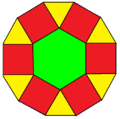Pentagonal cupola
| Pentagonal cupola | |
|---|---|
 | |
| Type |
Johnson J4 - J5 - J6 |
| Faces |
5 triangles 5 squares 1 pentagon 1 decagon |
| Edges | 25 |
| Vertices | 15 |
| Vertex configuration |
10(3.4.10) 5(3.4.5.4) |
| Symmetry group | C5v, [5], (*55) |
| Rotation group | C5, [5]+, (55) |
| Dual polyhedron | - |
| Properties | convex |
| Net | |
|
| |
In geometry, the pentagonal cupola is one of the Johnson solids (J5). It can be obtained as a slice of the rhombicosidodecahedron. The pentagonal cupola consists of 5 equilateral triangles, 5 squares, 1 pentagon, and 1 decagon.
A Johnson solid is one of 92 strictly convex polyhedra that have regular faces but are not uniform (that is, they are not Platonic solids, Archimedean solids, prisms or antiprisms). They were named by Norman Johnson, who first listed these polyhedra in 1966.[1]
Formulae
The following formulae for volume, surface area and circumradius can be used if all faces are regular, with edge length a:[2]
Related polyhedra
Dual polyhedron
The dual of the pentagonal cupola has 10 triangular faces and 5 kite faces:
| Dual pentagonal cupola | Net of dual |
|---|---|
 |
 |
Other convex cupolae
| n | 2 | 3 | 4 | 5 | 6 |
|---|---|---|---|---|---|
| Name | {2} || t{2} | {3} || t{3} | {4} || t{4} | {5} || t{5} | {6} || t{6} |
| Cupola |  Digonal cupola |
 Triangular cupola |
 Square cupola |
 Pentagonal cupola |
 Hexagonal cupola (Flat) |
| Related uniform polyhedra |
Triangular prism |
Cubocta- hedron |
Rhombi- cubocta- hedron |
Rhomb- icosidodeca- hedron |
Rhombi- trihexagonal tiling |
Crossed pentagrammic cupola
In geometry, the crossed pentagrammic cupola is one of the nonconvex Johnson solid isomorphs, being topologically identical to the convex pentagonal cupola. It can be obtained as a slice of the nonconvex great rhombicosidodecahedron or quasirhombicosidodecahedron, analogously to how the pentagonal cupola may be obtained as a slice of the rhombicosidodecahedron. As in all cupolae, the base polygon has twice as many edges and vertices as the top; in this case the base polygon is a decagram.
It may be seen as a cupola with a retrograde pentagrammic base, so that the squares and triangles connect across the bases in the opposite way to the pentagrammic cuploid, hence intersecting each other more deeply.
References
- ↑ Johnson, Norman W. (1966), "Convex polyhedra with regular faces", Canadian Journal of Mathematics, 18: 169–200, doi:10.4153/cjm-1966-021-8, MR 0185507, Zbl 0132.14603.
- ↑ Stephen Wolfram, "Pentagonal cupola" from Wolfram Alpha. Retrieved July 21, 2010.